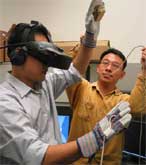Stroke patients who face months of rehabilitation to regain the use of impaired limbs may benefit from new haptics systems developed at the University of Southern California.
The applications are challenging stroke patients to grasp, pinch, squeeze, throw and push their way to recovery.
![2005_05_24_haptics3[1].jpg](http://www.we-make-money-not-art.com/yyy/2005_05_24_haptics3%5B1%5D.jpg)

“Haptics, which adds the sense of touch to 3-D computing, lets stroke patients interact with virtual worlds by feel,” said Margaret McLaughlin. “The big advantage is that we can control the environment and design cyber tasks that target each patient’s impairment.”
“Pincher” is designed for two-fingertip contact with virtual objects. The user dons a pair of goggles and puts a thimble on the forefinger; the thimble is connected to a force-feed device, called a PHANToM. The stylus of a second PHANToM is affixed to the thumb. The two PHANToMs provide the sensation of force to the fingertips as (s)he tries to pick up a cube and squeeze it.
Another interface is a “mutual touch” task for hand-reaching and grasping exercises. A “cyber grasp” exoskeleton, which fits over an data glove, measures the position and orientation of the hand in a 3D space. The glove allows patients to feel the sensation of a solid object in their palms, they can “pick up” a glass and pour milk out or stack books on shelves.
Via Eurekalert. More pictures at USC Viterbi and at the Haptic lab.
